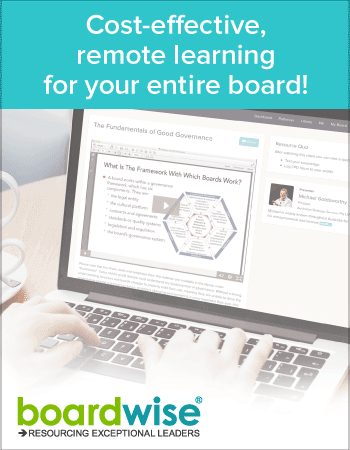Board Meeting Mastery: How Should a Chairperson Run the Meeting?
-
governance
Governance Board Meeting Mastery: How Should a Chairperson Run the Meeting?
When it comes to mastering the running of a board meeting, there is no manual for a Chairperson of the Board to consult. This is because every organisation has its own culture, set of laws and bylaws, and legal considerations to follow. If you are running a private board meeting or one for a nonprofit, there is no set of rules to follow.
Customised Agendas for Your Board Meeting
For newer companies, establishing a template for your board meeting is the basis to your success. If you are established, you likely have a method to your monthly board meeting madness. At minimum, keep these parts of every meeting the same:
- A custom agenda for every meeting
- Following an agenda template for order of events (For example, Finance always follows Marketing)
- Same time and place for a monthly meeting
- Secretarial review of past meetings with agenda review
What Are the Signs of an Effective Board Meeting?
Thanks to all of the business professionals before you, a board meeting can follow a set format. Research completed by the chairperson of the board of a publicly traded company (Drew Industries) found the signs of an effective board meeting to be:
Preparing participants
- Presenting a clear agenda to all attendees
- Offering action items with short descriptions so discussion participants can prepare
- Creating a road map for the decision-making process (present proposal, followed by rebuttals, followed by questions, and finished with a vote for example)
- Assigning deliverables to propel monthly progress forward
- Set deadlines for required responses and on deliverables
- Distributing key documents after the meeting or for issues discussed
Set up Your Board Meetings
Whether you have a start-up and need to set a precedent or are one signature away from going public, it is never too late to develop a board agenda and series of protocols. A great starting point is with a sample agenda from an established company or with the input of an experienced board member.
Establish Patterns
Protocols get established as issues come up. Don’t know the dates of audits? Now you know to use an annual board calendar to record and keep track of these dates. Can’t remember dates like compliance and other renewals? Add it to the agenda of a specific month every year. Focused on annual fundraisers? Elect a frontrunner every March. Record and establish protocols!
There are no one-size-fits-all structures for your board to follow but patterns get the job started. As long as you are making an effort to improve your business and its board meetings, you are doing more than most. Allow the format of your meetings to evolve.
Sample Agenda Including Protocols
Here is a sample agenda that follows common board member protocols:
- Make sure the secretary is taking meeting minutes, recording all actions
- Call the meeting to order
- Record attendees and the attainment of making quorum
- Reading of the minute from the last meeting
- Approve the minutes from the last meeting
- Listening to the reports and updates from previous meetings
- Voting on issues are reported on by committees
- Checking up on financial reports always reviewed
- Run through the status of all debits, credits, and debts
- Review legal matters, litigation, and settlements
- Discuss business matters, including everything from industry news about the competition to personnel announcements
- Bring up unfinished business, new business, and then announcements
- Adjourn the meetings
The Executive Committee and the Board
For smaller private companies, an executive committee often works alongside the board. The executive committee works on behalf of the board within the organisation. For example, they handle topics that don’t fall into other groups like the finance committee. If a task falls under the direction of multiple people, an executive committee tracks projects.
At board meetings, the executive committee may present opinions after conducting research on behalf of the board. Topics a committee is able to handle include: long-term operating strategies, acquisitions and dispositions, use of cash, human resources and personnel issues, and capital projects.
Board members can focus on making decisions and not conducting research in their monthly meetings thanks to committees.
What is an Executive Session?
Running a company requires more than one monthly board meeting. An executive session is a meeting that involves board directors without other executives and other staff members present. This could also involve the directors the actively work at the company while independent directors are not present (as they aren’t commonly in the office).
Using Executive Sessions
Holding executive sessions among internal directors helps unite the board for monthly meetings. Knowing the position of individuals and understanding viewpoints outside of a long meeting helps drive understanding of the company. Check in with executive sessions, not in executive committee meetings or board meetings.
Problems That Plague the Chairperson of the Board
It is a standard occurrence for the chairperson of the board to be plagued by specific problems. Running board meetings is never easy, especially as you establish rules, regulations, and methods. Meeting effectiveness and efficiency are impacted by:
- Too many unfinished items lining the agenda
- Adding complex issues to board meetings
- Allowing the opinion of too many directors to cloud the votes
- Too much cross-talk among directors
- Not assigning the right people to an executive committee
- Unbalanced meeting discussions
- Spending time on trivialities
- Lack of targeted decision-making or clear cut decisions
- An ill-informed secretary
- Chronic absenteeism or lack of commitment to monthly in-person meetings
- Barely meeting quorum because of lack of commitment
- Honesty in board member reelection
- Lack of board self-evaluation
- A director with a lack of commitment
Identifying the major issues that plague a board meeting is the most difficult part of cleaning up your habits. Once you notice one of these common issues, fixing it involves a direct discussion with your team. For example, if certain directors are dominating the conversation then start enforcing your speaking and time limit rules.
A Final Word on Board Discussions
Remember, it’s difficult to conduct a perfect board meeting but a complete commitment by the director and secretary helps change the company culture. The board secretary plays in major part in preventing board meeting problems as he or she directs the flow of the meeting, recalls previous events, and records current ones. As chairman knows when to make a final decision and maintains an air of respect along with approachability.
Make use of board evaluations, whether with anonymous or self-evaluations. Board directors should take pride in their participation on your private or nonprofit board. If something or someone isn’t working, identify the problem and move forward with your company.



